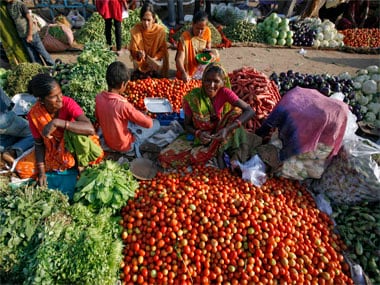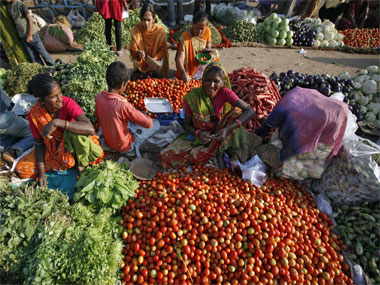Mumbai: The marginal on-month fall in consumer price index-based (CPI) inflation for March to 5.17 percent, largely on account of a decline in food and vegetable prices, has come in as unexpected to most economists. The corresponding figure in February was 5.37 percent.[caption id=“attachment_2152021” align=“alignleft” width=“380”]
 Cheaper vegetables. Reuters[/caption] Food inflation eased to 6.14 percent in March from 6.88 percent, while the core part of the CPI remained largely sticky at 4.15 percent as against 4.10 percent in February. The prices of food and beverage items eased to 6.20 percent from 6.76 percent. The easing trend in retail inflation is indeed good news for those hoping for more rates cuts from the Reserve Bank of India (RBI) and, if seen together with the recent lending rate cuts by banks, keep the hopes of more rate cuts alive. What is the not-so-good part is that the March inflation doesn’t fully reflect the impact of the unseasonal rains on food prices. This may reflect in the coming months. Secondly, the benefit of base effect, which makes inflation seem lower, is still there during March and April. From May, this would begin to fade. According to DK Joshi, chief economist at rating agency, Crisil, the impact of unseasonal rains may reflect in inflation numbers in the ensuing months. “The impact can be assessed only after seeing how good the monsoon is going to be,” said Joshi. The actual nature of the monsoons will be clear only around mid-July. While a good monsoon can somewhat mitigate the impact of the unseasonal summer rains on food prices, a bad one can do more damage. In that case, the CPI can inch up as the year progresses, limiting the headroom for Raghuram Rajan to cut rates further. The RBI, which kept the repo unchanged at 7.5 percent on April 7, expects the inflation to stay below 6 per cent throughout this year and to be somewhere around 5.8 per cent by the end of the fiscal year 2016. The inflation has so far obliged to the gliding path predicted by the Urjit Patel panel, giving space to Rajan to reverse the rate course. If the monsoon is normal and crude oil prices do not post a significant rebound, the CPI is likely to stay below 6 per cent paving way for future rate cuts by 25 to 50 basis points (bps) over the remainder of 2015. One bps is one hundredth of a percentage point. If not, the central bank may not hurry to cut rates. So far this year, the RBI has cut its rates twice by a cumulative 50 bps. If one revisits the policy statement, among the conditions Rajan presented to further cut rates, are proper monetary policy transmission and factors that support sustainable downward trend in inflation. Post the RBI caution on 7 April, banks have begun cutting their base rates or minimum lending rates, thus responding to the central bank’s policy signals. The behavior of the other parts—good monsoons and low oil prices— is critical for the central bank to chart its course of future action. For now, March inflation number doesn’t offer any compelling reason for Rajan to act. (Data support from Kishor Kadam)
Cheaper vegetables. Reuters[/caption] Food inflation eased to 6.14 percent in March from 6.88 percent, while the core part of the CPI remained largely sticky at 4.15 percent as against 4.10 percent in February. The prices of food and beverage items eased to 6.20 percent from 6.76 percent. The easing trend in retail inflation is indeed good news for those hoping for more rates cuts from the Reserve Bank of India (RBI) and, if seen together with the recent lending rate cuts by banks, keep the hopes of more rate cuts alive. What is the not-so-good part is that the March inflation doesn’t fully reflect the impact of the unseasonal rains on food prices. This may reflect in the coming months. Secondly, the benefit of base effect, which makes inflation seem lower, is still there during March and April. From May, this would begin to fade. According to DK Joshi, chief economist at rating agency, Crisil, the impact of unseasonal rains may reflect in inflation numbers in the ensuing months. “The impact can be assessed only after seeing how good the monsoon is going to be,” said Joshi. The actual nature of the monsoons will be clear only around mid-July. While a good monsoon can somewhat mitigate the impact of the unseasonal summer rains on food prices, a bad one can do more damage. In that case, the CPI can inch up as the year progresses, limiting the headroom for Raghuram Rajan to cut rates further. The RBI, which kept the repo unchanged at 7.5 percent on April 7, expects the inflation to stay below 6 per cent throughout this year and to be somewhere around 5.8 per cent by the end of the fiscal year 2016. The inflation has so far obliged to the gliding path predicted by the Urjit Patel panel, giving space to Rajan to reverse the rate course. If the monsoon is normal and crude oil prices do not post a significant rebound, the CPI is likely to stay below 6 per cent paving way for future rate cuts by 25 to 50 basis points (bps) over the remainder of 2015. One bps is one hundredth of a percentage point. If not, the central bank may not hurry to cut rates. So far this year, the RBI has cut its rates twice by a cumulative 50 bps. If one revisits the policy statement, among the conditions Rajan presented to further cut rates, are proper monetary policy transmission and factors that support sustainable downward trend in inflation. Post the RBI caution on 7 April, banks have begun cutting their base rates or minimum lending rates, thus responding to the central bank’s policy signals. The behavior of the other parts—good monsoons and low oil prices— is critical for the central bank to chart its course of future action. For now, March inflation number doesn’t offer any compelling reason for Rajan to act. (Data support from Kishor Kadam)
Fall in March CPI inflation positive but monsoon holds key for future rate cuts
Dinesh Unnikrishnan
• April 13, 2015, 21:15:05 IST
RBI, which kept the repo unchanged at 7.5 percent on 7 April, expects the inflation to stay below 6 percent throughout this year and somewhere around 5.8 percent by the end of the fiscal year2016.
Advertisement
)
End of Article